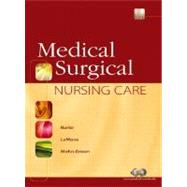
I. MEDICAL - SURGICAL NURSING PRACTICE.
Introduction to Medical-Surgical Nursing.
1. The Medical-Surgical Nurse.Alterations in Health Patterns.
5. Caring for Clients with Alterations in Fluid, Electrolyte, or Acid-Base Balance.II. HEALTH PERCEPTION - HEALTH MANAGEMENT PATTERN.
Altered Health Management Responses.
10. Caring for Clients Experiencing Trauma or Critical Illness.Altered Immune System Responses.
12. Caring for Clients with Inflammation and Infections.III. NUTRITIONAL - METABOLIC PATTERN.
Altered Integumentary System Problems.
14. Caring for Clients with Common Skin Problems.Altered Endocrine System Responses.
16. Caring for Clients with Pituitary, Thyroid, and Adrenal Disorders.Altered Nutritional Responses.
18. Caring for Clients with Nutritional and Upper GI Disorders.IV. ELIMINATION PATTERNS.
Altered Elimination Responses.
20. Caring for Clients with Bowel Disorders.V. ACTIVITY - EXERCISE PATTERN.
Altered Cardiovascular System Responses.
22. Caring for Clients with Cardiac Disorders.Altered Respiratory System Responses.
25. Caring for Clients with Upper Respiratory Disorders.Altered Musculoskeletal System Responses.
27. Caring for Clients with Musculoskeletal Trauma.VI. COGNITIVE - PERCEPTUAL PATTERN.
Altered Neurologic System Responses.
29. Caring for Clients with Intracranial Disorders.Altered Sensory Responses.
31. Caring for Clients with Eye and Ear Disorders.VII. SEXUALITY - REPRODUCTIVE PATTERN.
Altered Sexual and Reproductive System Responses.
32. Caring for Male Clients with Reproductive System Disorders.Appendices.
A: Standard Precautions.The New copy of this book will include any supplemental materials advertised. Please check the title of the book to determine if it should include any access cards, study guides, lab manuals, CDs, etc.
The Used, Rental and eBook copies of this book are not guaranteed to include any supplemental materials. Typically, only the book itself is included. This is true even if the title states it includes any access cards, study guides, lab manuals, CDs, etc.